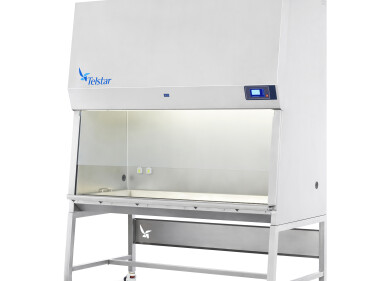Laboratory Products
Multiplex Fluorescent Western Blot Detection Using the BioSpectrum System
May 08 2013
Fluorescent western blotting employs secondary antibodies labelled with a fluorophore to perform direct, non-enzymatic detection of protein expression. Western blotting is commonly used for identification and quantification of specific proteins in a biological sample. Traditionally, a target protein is interrogated by antigen-specific antibodies which are then probed by secondary antibodies conjugated to either HRP or ALP and followed by colorimetric or chemiluminescent detection.
The BioSpectrum® Imaging System with BioLite™ Xe MultiSpectral Light Source allows for detection of multiple proteins such as in an immunoblot incubated with two different primary antibodies from different species and then probed with CyDye™-tagged secondary antibodies. Fluorescent blotting provides excellent signal stability as well as accurate quantitative analysis with broader dynamic range and high linearity, reducing or eliminating the need to strip and re-probe.
Materials and Methods
Two-fold dilutions of normal rabbit and mouse serums (Jackson Immuno Research Laboratories) were separated by SDS PAGE on 4-12% acrylamide gels (Invitrogen). The separated proteins were then transferred to nitrocellulose membranes.1 Blots were simultaneously probed with goat-∝-rabbit IgG – Cy3® and goat-∝-mouse IgG – Cy5® (GE Healthcare) secondary antibodies at 1:1250 concentration in Western Breeze blocking buffer (Invitrogen) for one hour incubation at room temperature. Blots were washed in secondary antibody incubations with 4 x 5 minutes in tris-buffered saline (PBS) containing 0.1% Tween 20.
The BioSpectrum with BioLite Xe (UVP, LLC) was used for fluorescent imaging. The processed blot was positioned on the sample platform. Excitation and emission wavelengths were selected and lens aperture set at f/1.2. Exposure time was adjusted for maximal signal and ranged from 1 to 5 seconds. Once acquired, VisionWorksLS Software (UVP, LLC) globally removed the image background intensity. The image was pseudocolored green and red to indicate Cy3 and Cy5, respectively. The image illustrates the multiplex imaging capabilities of the BioSpectrum, specifically separating out the signal of both Cy3 and Cy5 color channels.
Conclusion
Fluorescent western blotting applications offer many advantages over chemiluminescent or chromogenic visualisation. Most significantly, fluorescent labels permit multiplexing so that several proteins in a sample can be detected and analysed at the same time on a single protein blot. Fluorescent labels in particular offer very low background and high signal-to-noise ratio for quantitative imaging.
Compared to laser scanning systems where imaging times range from 3 to 5 minutes, the BioSpectrum provides a significant advantage with imaging times ranging from 1 to 5 seconds for fluorescent Western blotting applications.
The combination of the BioSpectrum with the BioLite provides not only a full range of wavelengths for excitation light but also rapid high resolution image capture through the use of deeply cooled MegaCam 810 and OptiChemi™ 610 cameras and low light lenses. Fluorescent Western blot imaging with the BioSpectrum is a fast and efficient process for enabling researchers to achieve simultaneous detection of multiple proteins on the same immunoblot and generate publication-ready images.
References
1. Gallagher, S.R. and Wiley, E.A. Current Protocols: Essential Laboratory Techniques. Wiley, 2012
UVP, LLC Upland, California (909) 946-3197. Cambridge UK +44(0)1223-420022. Click here to email.
Digital Edition
International Labmate 49.6 - Sept 2024
September 2024
Chromatography Articles - HPLC gradient validation using non-invasive flowmeters Mass Spectrometry & Spectroscopy Articles - From R&D to QC, making NMR accessible for everyone: Putting NMR...
View all digital editions
Events
Oct 06 2024 Liverpool, UK
Oct 08 2024 Gothenburg, Sweden
Oct 09 2024 Birmingham, UK
Oct 09 2024 NEC, Birmingham, UK
Oct 15 2024 Milan, Italy





.jpg)














